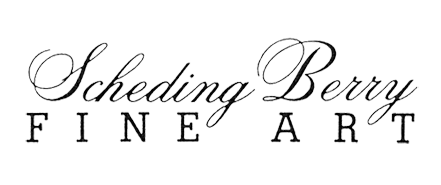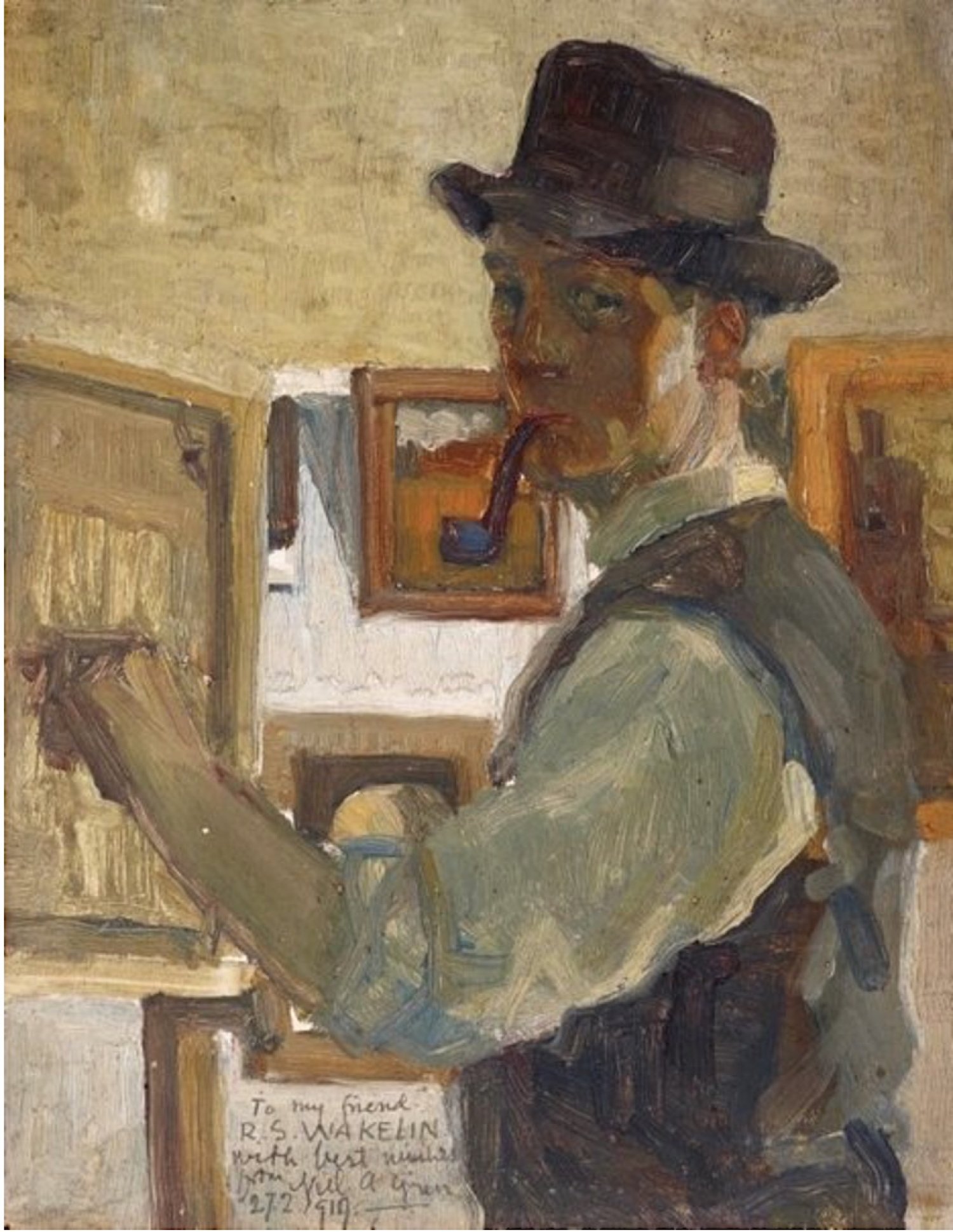Niel Gren
Self Portrait, 1919
To my friend/R S Wakelin/with best wishes/from Niel A Gren/27.2.1919
28.5 x 22 cm
SOLD
Provenance:
The estate of Roland Wakelin; Macquarie Galleries (auction in aid of the Blind Society, 18th April, 1983).
Exhibitions:
Sydney Moderns – Art for a New World, curated by Deborah Edwards and Denise Mimmocchi, Art Gallery of NSW, 2013.
Literature:
Illustrated The Artist, 1941 (cover illustration); Early Sydney Moderns, Jean Campbell, Craftsman House, 1988, p31; Sydney Moderns – Art for a New World, curated by Deborah Edwards and Denise Mimmocchi, Art Gallery of NSW, 2013, p40.
While the artist has signed this work ‘Niel A Gren’ he was born Nils Ahgren (in Sweden in 1893). Later in America he was known as Nils Gren . (The Artist’s working names authority list, published by the National Gallery of Australia in 1990,[i] gives both ‘Niel Gren’ and ‘Nils A. Gren’ as the correct name). He had left Sweden in 1912 at the age of nineteen[ii]. In 1916, at the age of 23, he was in Sydney, studying with Dattilo-Rubbo[iii] and then working alongside Roland Wakelin (and other artists such as Lloyd Rees, Percy Leason and Albert Collins) at the commercial art firm of Smith and Julius, run by Sydney Ure Smith and his friend the artist Harry Julius.[iv] It is not known where Gren was or what he was doing between 1912 and 1916. Jean Campbell in Early Sydney Moderns[v] records a story told by Wakelin that in 1916 Gren had returned in an excited state from a visit to the Royal Art Society Students Exhibition to meet Wakelin outside the Smith and Julius offices in Bond Street where he exclaimed to Wakelin: ‘Some mad man has bought your picture – Yon Yung [John Young, the art dealer]’. Wakelin used the adjective ‘harem-scarum’ to describe Gren’s personality. It has been suggested[vi] that Gren was making what was intended to be a short stop in Australia but ‘the advent of World War I made it necessary for him to remain in Sydney’. This suggests it was possible that he may have been here around 1914. However, no references have been found of his presence in Australia prior to 1916. Given that Gren went to America in 1919 it would seem that the self portrait in this collection, painted in February of that year, is a farewell gift to his friend Wakelin. At the time Wakelin and Roy de Maistre would have been preparing for their seminal ‘Colour in Art’ exhibition. It is tantalising to wonder whether the painting Gren has been working on in the self portrait (the one on the easel which is turned away from the viewer) relates to this brilliant body of work. A painting on the wall behind Gren, while not high-keyed, has a high horizon line typical of the Berry’s Bay landscapes exhibited by de Maistre and Wakelin in their 1919 exhibition. At the very least this self portrait, which shows the artist Gren in a workmanlike, more than a romantic pose, is enough to demonstrate his brief involvement with the Modern movement in Sydney. Only four or five Australian works by him are known to exist today. What happened to Gren after he left Australia? None of our own art histories tell us this. A Californian art gallery, Spencer Jon Helfen Fine Arts, has provided the following information: • Gren first lived in New York City, where he worked for several years as a designer for a pattern manufacturer, but by 1925 he was living in southern California. He resided in Los Angeles, studying with Stanton Macdonald Wright and exhibiting with the Painters and Sculptors of Los Angeles in 1926, and with the Modern Art Society of Los Angeles that same year.• In the late 1920s Nils Gren moved to San Francisco, exhibiting with the San Francisco Art Association in 1928 and 1929. • Around 1930 Gren destroyed all his earlier work [in a fire] but he went on to produce paintings with what became his signature style – nocturnes and fantastic images of people, places and objects. • Gren’s paintings were widely exhibited, including at the Paul Elder Gallery, where he had a solo show in 1932. (The San Francisco Chronicle described Gren’s paintings in these terms: ‘There is a peculiar sombreness, both of color and of light and shadow, in his work [and]… a certain characteristic twist of line and form [that] makes his pictures tensely alive.’ His work also was exhibited in many museum shows, including the Oakland Art Gallery in 1932 and 1934, the San Francisco Museum of Art Inaugural Exhibition in 1935, the Palace of the Legion of Honor, and also at the Golden Gate International Exposition in 1939 and California State Fairs throughout the decade. • During the 1930s, Nils Gren produced lithographs for the Works Progress Administration, and worked with other artists on murals for San Francisco’s Mission High School. He also produced a colourful mural for his friend, restaurateur and former bootlegger Isadore Gomez, for Gomez’ 848 Pacific Street restaurant. • A 1940 exhibition of Gren’s paintings at the San Francisco Museum of Art prompted these comments from San Francisco Chronicle critic Alfred Frankenstein: ‘Mr. Gren’s best pictures are fantastic, moody, imaginative landscapes in oil, with the looping rhythms characteristic of his approach.’ Later that same year Nils Gren passed away in San Francisco. His work is included in many public collections, including the Smithsonian Institution and the Oakland Museum. Another art dealer, Steve Macfarlane from Santa Barbara, wrote to Stephen Scheding to say that Gren’s works were very rare, most being destroyed by the fire in the late 1930's. He added that Gren had committed suicide in 1940. There is a very interesting connection in relation to Gren studying with Stanton Macdonald Wright in Los Angeles. Roy de Maistre had read W. Huntington Wright’s Modern Painting, published in 1915,[vii] which had a final chapter on ‘Synchromism’ with a colour plate of the painting Arm Organisation in Blue-Green by Stanton Macdonald Wright who was the author’s brother. Humphrey Macqueen in The Black Swan of Trespass has noted the ‘striking resemblance’ of de Maistre’s 1919 colour harmony paintings to the Macdonald Wright work.
[i] Australian Art - Artist’s working names authority list, compiled by Helen Maxwell, assisted by Philippa Kelly, Australian National Gallery, 1990, 489 pp. (First published 1983, updated September, 1989).[ii] See Spencer Jon Helfen Fine Arts (Californian Modern Art) website: http://www.helfenfinearts.com/ex2005Fset.html[iii] Cav. Anthony Dattilo-Rubbo – Painter and Teacher and some prominent pupils, Manly Art Gallery catalogue, 1981, p33; McCulloch’s Encyclopedia of Australian Art.[iv] Jean Campbell, Early Sydney Moderns, Craftsman House, 1988, p11.[v] Jean Campbell, Early Sydney Moderns, Craftsman House, 1988, p11 and p32.[vi] See Spencer Jon Helfen Fine Arts (Californian Modern Art) website, op cit.[vii] Humphrey Macqueen, The Black Swan of Trespass, Alternative Publishing Cooperative, 1979, p5; Heather Johnson, Roy De Maistre The Australian Years 1894 – 1930, Craftsman House, 1988.




